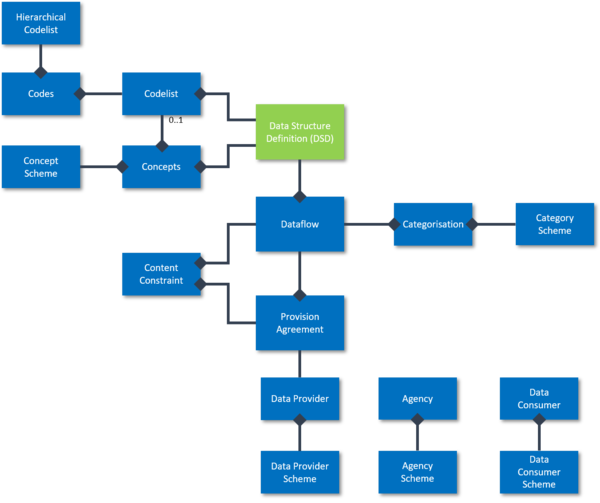Difference between revisions of "Data Structure Definition"
(→Context within the SDMX 2.1 Information Model) |
(→Context within the SDMX 2.1 Information Model) |
||
| Line 29: | Line 29: | ||
<p>The schematic illustrates the core artefacts of the SDMX 2.1 Information Model, and how the Data Structure Definition relates to other structures.</p> | <p>The schematic illustrates the core artefacts of the SDMX 2.1 Information Model, and how the Data Structure Definition relates to other structures.</p> | ||
| − | <p> | + | <p>Data Structure Definitions use Concepts and optionally Codelists to describe the [[Dimensions]], [[Attributes]] and [[Measures]] that make up a dataset.</p> |
==Usage== | ==Usage== | ||
Revision as of 08:36, 19 December 2019
Contents
Overview
An SDMX Data Structure Definition (DSD) describes the structure of a dataset in terms of its dimensions, attributes and measures.
Structure Properties
| Structure Type | Standard SDMX Structural Metadata Artefact |
|---|---|
| Maintainable | Yes |
| Identifiable | Yes |
| Item Scheme | No |
| SDMX Information Model Versions | 1.0, 2.0, 2.1 |
| Concept ID | DSD |
Context within the SDMX 2.1 Information Model
The schematic illustrates the core artefacts of the SDMX 2.1 Information Model, and how the Data Structure Definition relates to other structures.
Data Structure Definitions use Concepts and optionally Codelists to describe the Dimensions, Attributes and Measures that make up a dataset.
Usage
SDMX Codelists are lists of classification codes used principally for defining the set of allowed values for enumerated Components in Data Structure Definitions (DSDs) or Metadata Structure Definitions which describe Reference Metadata.
Each code is a separate Item so must have an ID and a Name, but can also have an optional Description. While Code IDs must be unique within a Codelist, the same Code ID may be safely used in other Codelists. For instance: The code 'A' may be used in a Frequency Codelist to represent 'Annual', but also appear in an Industry Codelist to represent 'Agriculture'.
